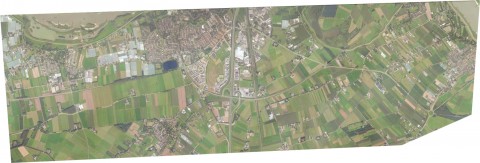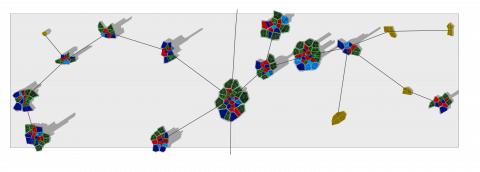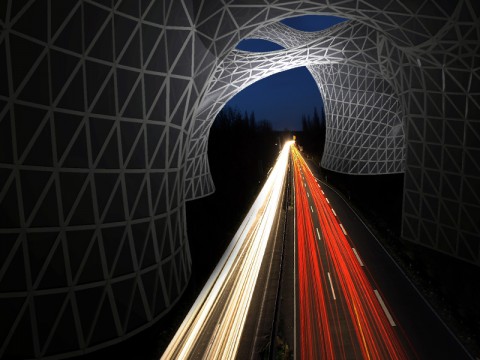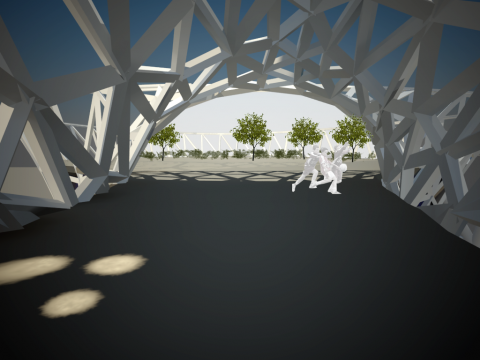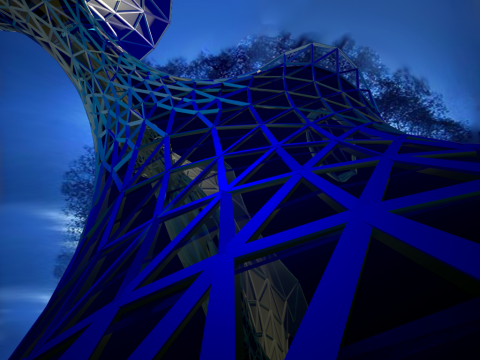Urban networks of distributed intelligence
The extraordinary flow of information from the site morphologies of the highway sectors, from the movement of people by car and from the Virtools database provide a ground for the development of a self-adapting project. River, lakes, canals – the Maas and Waal – and the motorway constitute attractors for it. The highway feeds it. Seen from this perspective, the site becomes an organism that lives its own life. This project, therefore, redefines the construct of urbanity along the highway with a generative system that uses the flow of information to nourish its progression.
It is possible to mutate the distribution of the parts of the organism, both with a top-down decisional approach and with internal attraction/repulsion rules. The creature in this way establishes only certain connections with other parts. E.g., housing attracts particularly industry (because of the need of workers) but industry is pulling to itself essentially only green (because the other species are refrained by pollution, noise, heavy traffic, etc.).
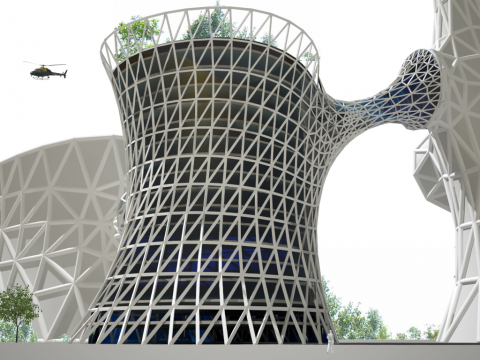
A seeding system for the city
The field of multi-agent systems deals with the idea that a set of entities with little apparent intelligence can in fact develop a large and complex behaviour, given that they all respond to simple and well-established rules. This scheme, which derives from biology, is noticeable among others in the construction of an ant colony, or in the movements of a school of fish avoiding a predator. Sociology describes this structure as superorganism.
A number of agents is spread on the whole site, using the software Virtools. The number of each species is proportional to the requirements of the site, and inversely proportional to the defined body-size index derived from the program. Following the biological parallelism, each agent has senses. They are implemented in a series of ranges, first being the preferred minimal distance to the next neighbour, the second being the area of interaction and the third being the range of sight for each agent. All three ranges are given as distances, which establish thresholds and are stored in a matrix of size in the senses script of each agent.
Each agent has also an interaction chromosome, which defines the response to the stimuli provided by the senses: it is a coefficient to the autonomous acceleration. If the coefficient is positive, the result will be movement toward, otherwise repulsion from the neighbour. At the same time, the neighbour will apply its own coefficient and therefore will establish nine scenarios (A approaches B, A follows B while B escapes, B avoids A, A and B get closer, B approaches A, B follows A while A escapes, A avoids B, A and B diverge – and no response). Additionally, each agent has a starting speed and a lifetime.
To deal with the context and the neighbours, a layer of fixed attractors and repellents is derived from a site analysis (figure 4) and is located in particularly interesting points (figure 5). In this way, the geography of the sector can inform the site. Agents form flocks of villages or cities, weaving a perennial network of relationships on the site. This is also a facet of the underlying idea of the site as a complexity of exchanges where location triggers action. It is interesting to notice that, because of the abovementioned set of relations in the matrix, city centres are usually made of housing units, and periphery contains green.
Germination: cellular development
Given the volumetric definition of the city and its positioning, the underlying idea is that the whole superorganism lives of networks of relationship. In the field of graph theory, a shortest path graph among the species could help the city developing further its potential. A diagram shows the shortest path graph on the urban level and realistically traces the routes of infrastructure and services.
There are many ways to implement the cellular development of the network within one city. It could be a purely virtual arrangement with an infrastructural or organic nature– e.g. as an access to the web, or it could be material.
If the designer chooses the infrastructure, the network could become a relation made of pipes or of bridges, otherwise it could simulate the development systems typical of cells: membranes. For consistency with the theme of the project, the choice is clearly the latter.
The main characteristic of membranes is superficial tension, which allows the cell to expand and reach crucial areas while having the smallest outer surface. The area needing to be connected is the portion around the barycentre of each volume, because this ensures the shortest walking distance to the rest of the building. To construct this geometry, the project uses a portion of code developed by David Rutten and called “mesh relaxation”, with Rhinoceros. Tessellation, anchor points, geometric input, tension force and mesh welding are external parts to that script that run in parallel and differentiate the five programs.
Housing has a generally smaller total volume and rather tight apertures. Therefore, the tessellation is quite small and the diameter of the anchor points is restricted. The volumes are smoothened by the high tensions. Office has still tight windows, but larger volumes and generally more prismatic shapes. Commercial has very large tessellation (for larger windows) and large communication ganglions to the neighbouring cells. All villages are a superorganism on their own, and could theoretically develop with different genetics.
Here you can see a video about this project.

